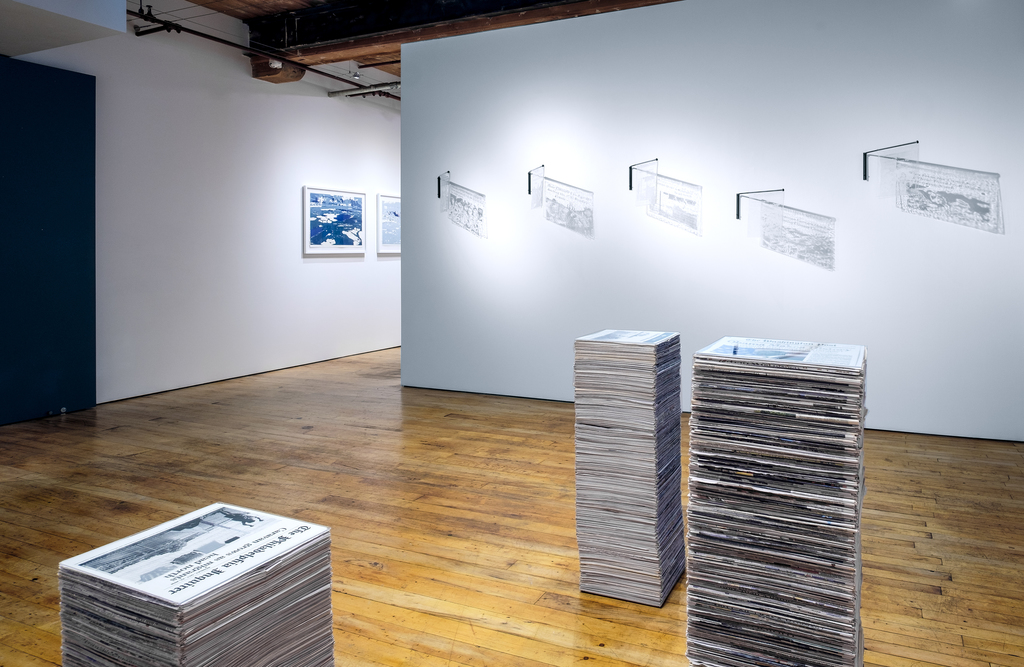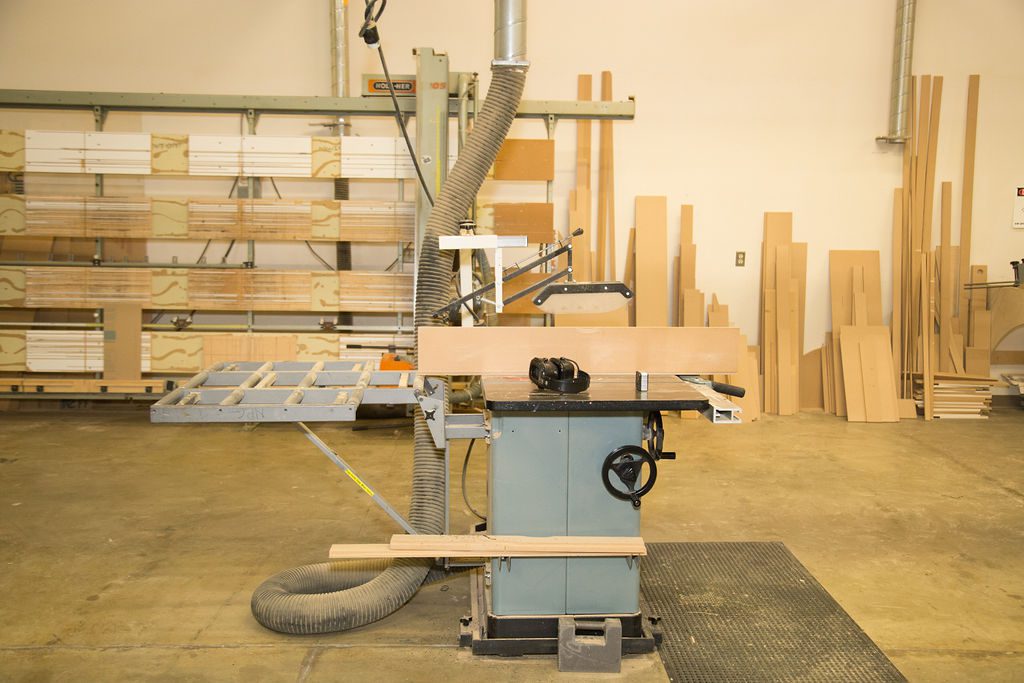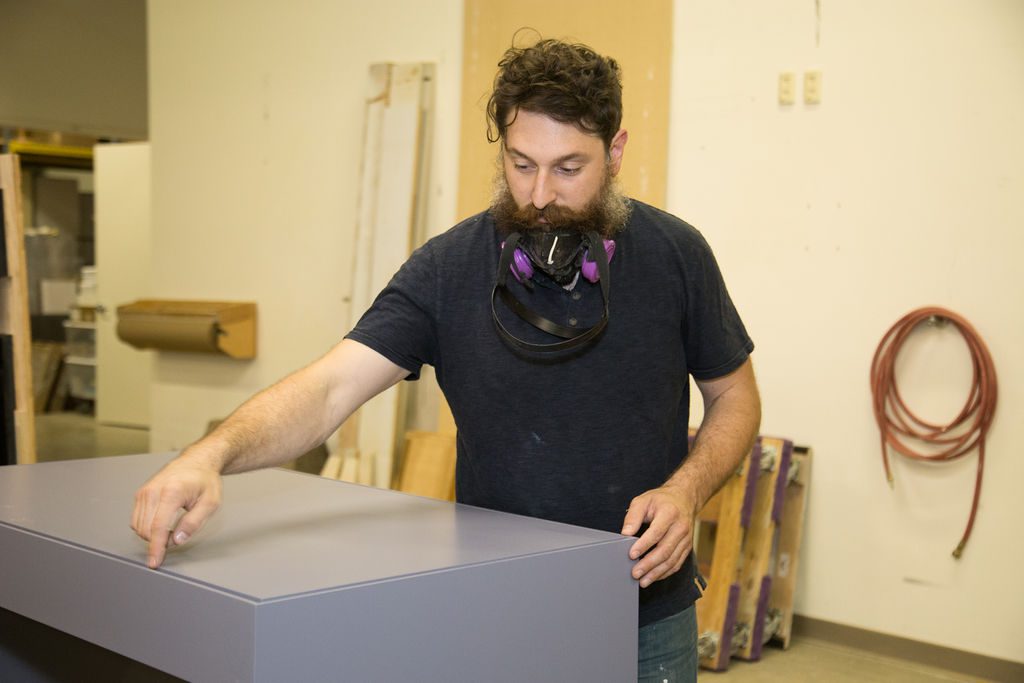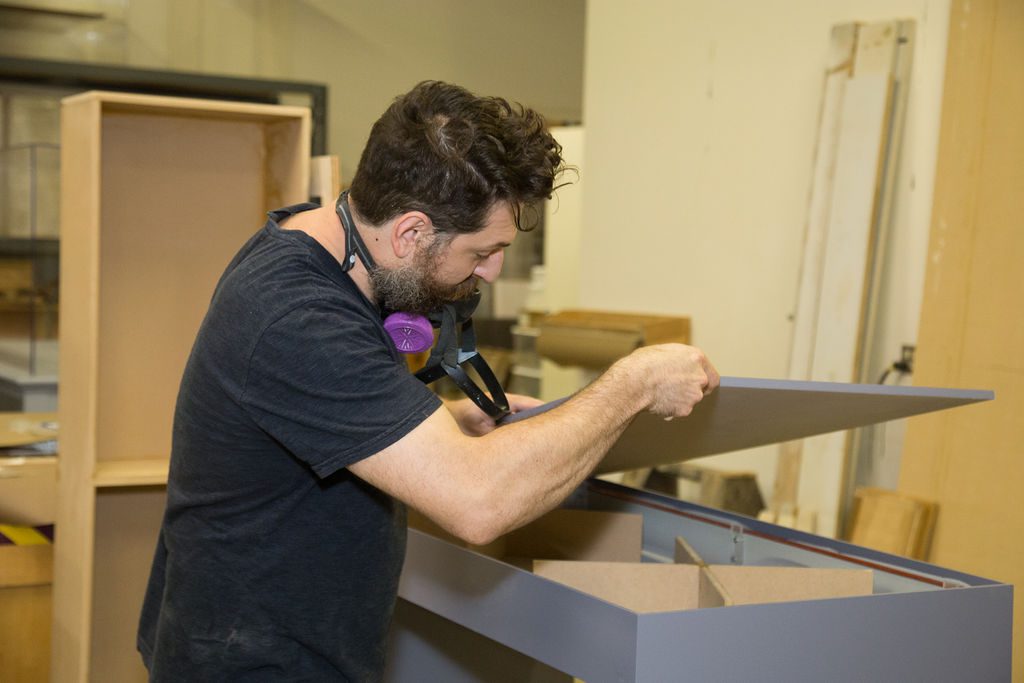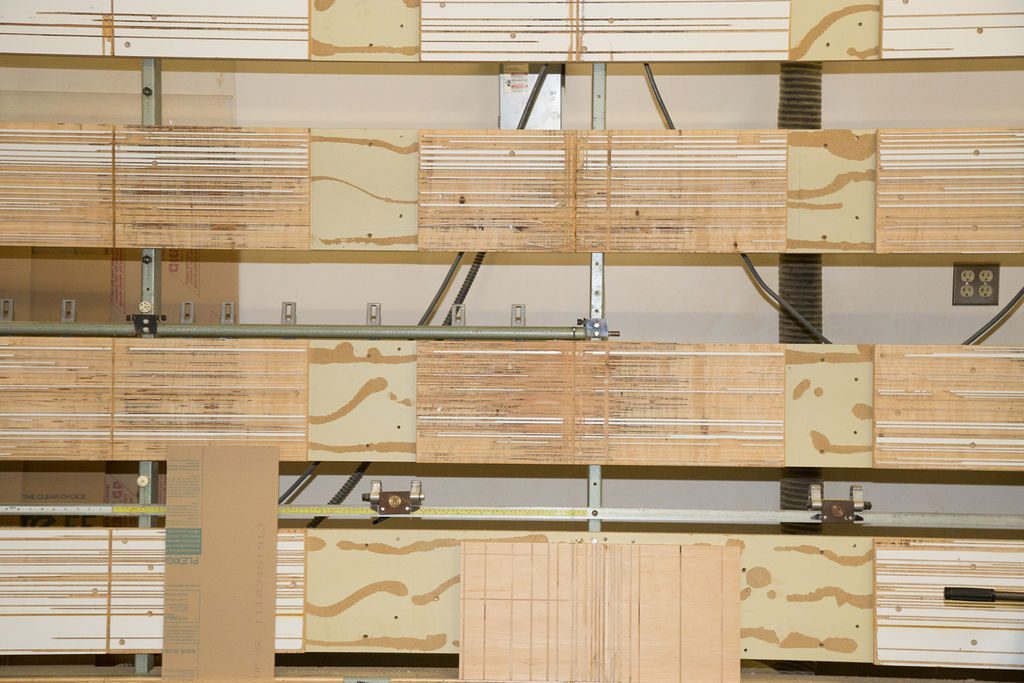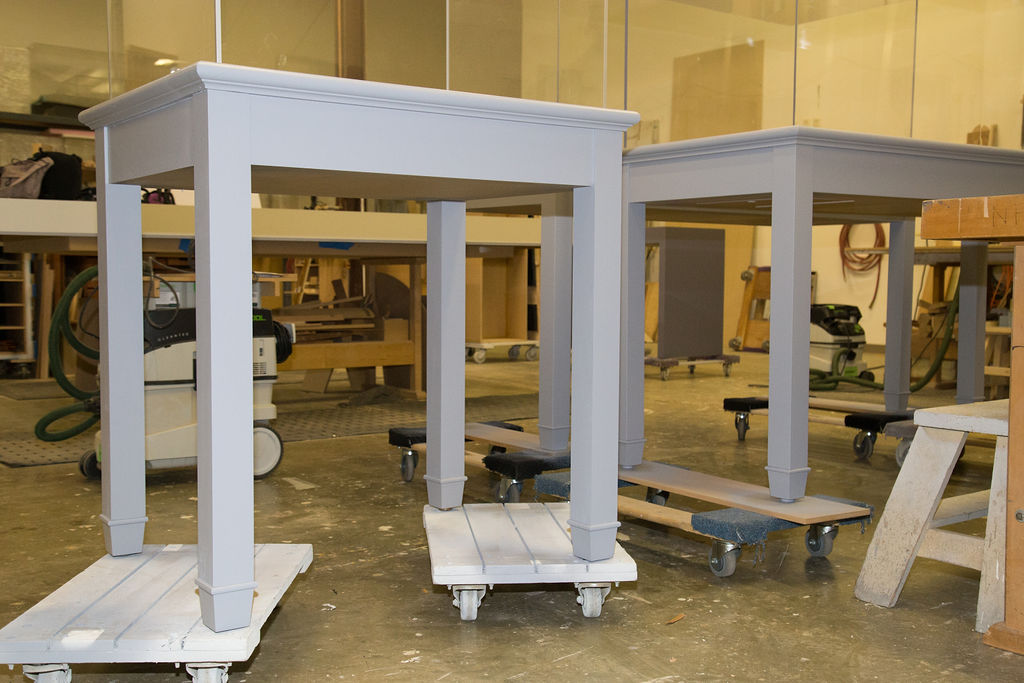Nick Primo spends his days measuring: how long it’s going to take on a given day to commute from Baltimore to his day job in Smithsonian American Art Museum’s (SAAM) cabinet shop, the milestones of his young son’s development, and the difference between cutting to the left or right of a 1/16” mark. Getting the timing right is the difference between sitting on I-95 for 90 minutes and making it home in time to go to the gym before it closes. What any woodworker could tell you is that cutting consistently “heavy or light” is the difference between all of the carefully milled parts of a piece of furniture lining up and having to start over.
On a sweaty day this past August, I met Primo in the house he shares with his wife, the jeweler Christine Herz, and their one-year-old son, Bodhi. Primo and Herz purchased the house two years ago and have been steadily fixing it up since while working full time and caring for their child. Primo manages to find time for his studio practice, using the different rooms of the home for his pottery wheel, welding equipment and woodworking tools. Herz jokes that sometimes she wakes up to a new sculpture that wasn’t there when she went to bed. About his prolific studio practice, Primo rationalizes, “When you have time to work you just have to. There’s no room for doubt, that can come after when you’re lying awake in bed.”
Primo describes his artwork, often comprised of wood, metal, and clay elements, as “minimal but not minimalism and based around a pared-down construction of an idea.” Inspired by architecture, furniture, and design, while attending MICA’s Rinehart School of Sculpture, it was a favorite joke of fellow students during Primo’s group critiques that they didn’t know if his work was a chair or a sculpture.

In SAAM’s cabinet shop, Primo builds actual furniture, primarily cabinets, plinths, vitrines, pedestals, cabinets, and the occasional frame. Primo kindly walked me through rabbets, dados, and grooves, the three standard cut shapes he has to mill over and over again with total precision to join the furniture he makes. A former K-12 teacher, the educator in Primo loves talking shop in his shop—over the course of our morning together, in addition to covering the basics of millwork, he explained to me the ins and outs of assembling acrylic display boxes (not made in the cabinet shop, too many fumes) and how to cut giant ellipses out of wood using a router while avoiding cutting off a body part.
Primo and his shop coworkers do both production and gallery installation; they make everything months in advance then truck it in and out. Once an install is complete, they return to the shop and start producing the next show. Everything is staggered and expertly scheduled but “there are always a million and one things to do.”
After four years in the shop, Primo feels like a veteran. “I feel like I’ve seen almost everything in terms of install hiccups,” he says. “There’s always a new problem, which is the fun, stressful, part of the job—figuring stuff out to make sure the curator’s happy, the registrar’s happy, the conservationists are happy—there’s a lot of people to please. We’re like ghosts in the museum, no one has any idea what we do.”
Primo is a graduate of Central Connecticut State University, which he credits for giving him a foundation in education and teaching him “how to be a learner.” He laughs that his ability to “learn how to do stuff” is his superpower and “the reason the truck still moves.” Our conversation centered on post-grad finances, the importance of fiction as a way of understanding philosophy, and why we should never stop learning.

SUBJECT: Nick Primo, 37
WEARING: Blue shirt, jeans, Nike runners: “I wear these pants and these shoes every day with a different shirt (sometimes); It’s my life uniform.”
PLACE: Rosebank, Baltimore and SAAM’s cabinet shop
Suzy Kopf: What is the most important book (or books) you’ve read?
Nick Primo: Carl Sagan’s Cosmos and Pale Blue Dot. Jill Lepore’s These Truths. Angela Davis’ Women, Race and Class. W. Somerset Maugham’s Of Human Bondage. Haruki Murakami’s Wind-Up Bird Chronicles. Kazuo Ishiguro’s Never Let Me Go.
What was the worst career or life advice you’ve ever received? What is the best?
The best and worst career advice: “Be careful what you get good at.”
If you couldn’t live in Baltimore/the DMV, would you live in New York City or Los Angeles? Another city?
I grew up in a small suburb of Hartford, CT. It was easy getting to New York City by way of Metro North out of New Haven. All through high school and undergrad I always thought of NYC as a playground for adults, like a theme park full of art, history, and food, a place to visit, but not to stay. I still feel that way. Maybe that’s a bit unfair. I’ve never been to LA. If I could pick a place to live, it would be the Netherlands, or some Scandinavian country where everyone bikes to work and they have great daycare, schools, and healthcare.
Did you have a favorite toy as a child? Do you remember what happened to it?
When I was 3 or 4, I had a typewriter and a black kite with big white eyes on the wings. I didn’t know how to read, but I would type away pretending to write stories. I would talk to the kite. I don’t know what happened to either of them.
What mundane thing do you hope you’re remembered for?
I have designated pockets for my phone, wallet, and personal effects. My keys hang on a carabiner from a belt loop on my left side. My pants have worn outlines from putting the same thing in the pockets everyday. If anything is missing, I feel it before I know it.
What’s the best local restaurant and what is your go-to order?
I like to eat, so here’s a couple. Jack and Zach’s Food: Everything tastes like someone made it from scratch. The sausage, egg, and cheese on toast is my go-to. Ekiben’s tackle box is probably the best fish fry I’ve ever had. I can probably eat my body weight in arancinis and stuffed peppers from DiPasquales. All their lasagnas are amazing also. Jake’s on Falls Road makes incredible ribs. I wish I had ribs from Jake’s right now.
If “artist” wasn’t a career that you could have chosen to pursue, is there another career path you think you would have excelled at with your skill set?
I’ve always felt really strange calling myself an artist, and if I can avoid saying it, I often do. I don’t think of art as my career path, but more of a means of self discovery. I know that sounds like new-age bullshit, but it’s true.
Do you have what might be described as an unusual hobby? What is it? How did you get into that?
I like exercising and video games, always have. Since having a baby I haven’t been able to do much of either. Bodhi, our son, got sick a few times this past year. Each time, he wanted to spend the better part of the day sleeping on my chest, which rooted me to the couch, but kept my hands free. And although he slept through all of it, I like to credit him with assisting me in beating Tomb Raider for PS3.
Whose work would you want in your home or to wear on your body? Specific piece?
I would wear Nick Cave Soundsuits everywhere. Lots of tassels, please!
If you had unlimited funding and time, describe the show you’d curate or the series of work you’d make.
Not sure what this says about me or my art practice, but if I had unlimited funding I would spend all my time buying old wood-working machines, refurbishing them, and tricking out my studio. I then would probably build a house that was equal parts inspired Antonio Gaudi, James Turrell, and Dieter Rams.
What are the last three emojis you used?
Heart
Heart
Heart
Do you have a typical day or not right now? Do you wish you had a routine if you don’t or do you thrive on change?
5:20 Wake up
6:15 MARC train to DC
7:30 Work start time
4:00 Work end time
4:17 MARC train to Baltimore
5:45 Home. Play with Bodhi
6:30 Bodhi bath and bedtime routine
7:00 Laundry/next-day meal prep
8:30 Make art or lie on the floor exhausted
9:00 Black out
Rinse Repeat…
Is there a show you’ve seen in the last five years that you are still thinking about? Why do you think that is?
The Jack Whitten show at the BMA was very well done. All of it. The layout, the millwork, it was all very considered and smart. Whoever designed it was not afraid of using platforms and pedestals as a means of leading the viewer, while still allowing for discovery. It appealed to me personally because of the line of work I’m in.
I have come to appreciate the museum/gallery space, and have become very sensitive to it. In art school, the white cube, or white space critique tips towards a negative discussion. The white space is sterile, alien, unnatural, blah blah blah.
I draw a lot in CAD and SketchUp for work; I also use those programs for house projects, furniture, and sculpture. The drawing programs feel like the same mental space I use when thinking of art forms and sculptural forms. They share an affinity with the white drawing ground or blank canvas. I had a connection with that show because all these spaces are connected: the mental/conceptual, the gallery/museum, the software and paper/ground drawing space. The art was great too!

What would your teenage self think of you today?
I think he would be relieved.
Did you have a formative and/or terrible first job? What was it?
While in undergrad I was required to complete two student teaching assignments where I had to shadow and then take over the classes of a collaborating teacher. The first assignment was K-5, and the collaborating was a horrible person. They were also well organized, efficient, and had great classroom management skills. You can learn a great deal from people despite their flaws.
What have you learned recently that made you think, “Oh, shit, how did I reach my mid-thirties without knowing this?!”
You don’t have to show up to anything on time, and always be nice to people you don’t know.

Photos by E. Brady Robinson

